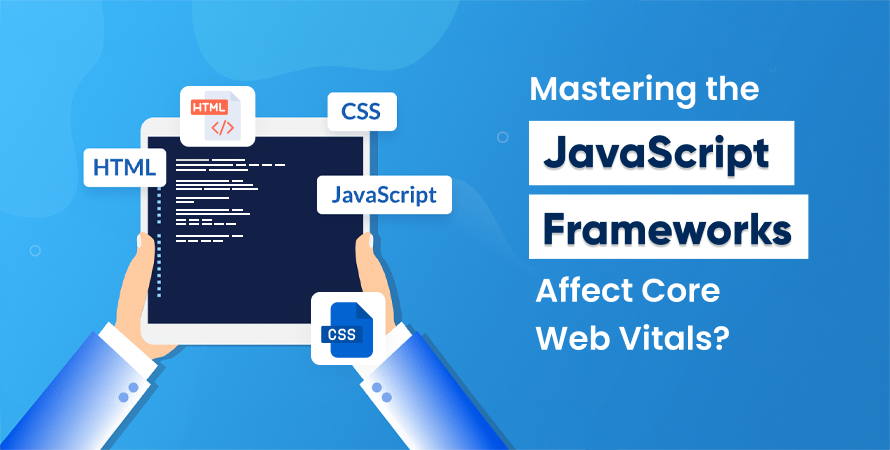How JavaScript Frameworks Affect Core Web Vitals



Introduction: Why Faster Isn’t Fast Enough Anymore
In a world where digital attention spans are measured in milliseconds, your site’s performance isn’t just about speed—it’s about perceived speed, stability, and responsiveness. This is precisely what Google’s Core Web Vitals (CWV) aim to measure. Whether you’re building a single-page app in React or experimenting with SvelteKit, your choice of JavaScript web framework will have a measurable impact on how Google—and your users—judge your website.
With Google making CWV a ranking signal, optimizing these metrics is no longer optional. But it’s not just about metrics on a report—it’s about real-world user experience, business conversion rates, and long-term scalability. In this blog, we dive deep into how popular JavaScript frameworks like React, Vue, Angular, and Svelte affect Core Web Vitals, and how to optimize your stack accordingly.
Let’s decode the intersection of performance and frameworks, and map a real-world Core Web Vitals strategy to ensure your frontend choices don’t sabotage your site’s UX.
Core Web Vitals 101
Core Web Vitals are a set of specific metrics defined by Google to quantify the user experience of web pages. These metrics assess loading performance, interactivity, and visual stability.
The Key CWV Metrics:
- Largest Contentful Paint (LCP): Measures how quickly the main content loads (target < 2.5s).
- Interaction to Next Paint (INP): Replaces First Input Delay (FID); measures responsiveness (target < 200ms).
- Cumulative Layout Shift (CLS): Measures visual stability (target < 0.1).
Understanding and improving Core Web Vitals is critical not just for SEO but for reducing bounce rates, increasing conversions, and ensuring a frictionless user experience.
The Role of JavaScript in CWV Performance
JavaScript is essential—but it’s also one of the biggest bottlenecks for performance. Top JavaScript frameworks like React or Angular introduce layers of abstraction that often slow down LCP and increase INP.
Common JS-related performance challenges:
- Hydration delays (especially in React)
- Excessive JavaScript bundle size
- Render-blocking scripts
- Delayed interactivity due to large event listeners
The type of rendering used—client-side (CSR), server-side (SSR), or static rendering—further complicates how a framework impacts Core Web Vitals. Your core web vitals optimization plan should include a deep understanding of how JS parsing and execution works in your framework.
Framework-by-Framework CWV Analysis
Let’s explore how each major JavaScript framework interacts with CWV and how to improve results within each environment.
React
React is powerful and popular, but it can negatively impact LCP and INP if not optimized. React apps often ship large JavaScript bundles, and hydration can delay interactivity.
Common CWV Issues with React:
- Large bundles increase LCP time.
- Hydration delays hurt INP.
- Lazy loading without placeholders increases CLS.
How to improve Core Web Vitals in React:
- Code splitting with React.lazy and dynamic imports.
- Use React Server Components for SSR where possible.
- Implement preload hints for critical resources.
- Optimize third-party scripts and defer non-critical ones.
- Compress images and serve them in modern formats.
React’s flexibility is a double-edged sword; a thoughtful core web vitals strategy can mitigate its pitfalls.
Vue.js
Vue provides a more lightweight structure compared to React, and its ecosystem includes Nuxt.js, which simplifies SSR.
CWV Strengths:
- Smaller initial footprint.
- Fine-grained reactivity helps reduce unnecessary re-renders.
Challenges:
- In larger apps, render bottlenecks can still appear.
- Improper component use leads to bloated DOM.
How to optimize Vue for CWV:
- Leverage Nuxt for SSR and static site generation (SSG).
- Use v-lazy for image loading.
- Implement smart prefetching with Nuxt modules.
- Avoid unnecessary watchers or deeply reactive objects.
Vue offers an excellent balance of performance and developer ergonomics if used with discipline.
Angular
Angular is a robust JavaScript backend framework and frontend solution, but its size and complexity often slow down LCP and INP.
Common pitfalls:
- Initial load time is often high due to the full-featured framework.
- Change detection across large components increases response latency.
Optimization strategies:
- Use Ahead-of-Time (AOT) compilation to reduce JS parsing time.
- Minimize zone.js impact using OnPush ChangeDetectionStrategy.
- Apply lazy loading at the module level.
- Implement Angular Universal for SSR.
Angular can deliver excellent CWV scores, but only with significant configuration and care.
Svelte
Svelte takes a unique approach—it compiles to minimal JavaScript, removing the runtime burden that plagues most frameworks.
CWV advantages:
- Minimal hydration needs.
- Near-zero runtime overhead.
- Excellent default performance for LCP and INP.
Best practices:
- Use SvelteKit for SSR and routing.
- Keep dynamic imports scoped to truly needed content.
- Minimize reactivity in global stores to reduce unnecessary DOM updates.
For developers serious about CWV, Svelte is arguably the best starting point out of the box.
Server-Side vs Client-Side vs Edge Rendering
Rendering strategy directly influences CWV:
| Rendering Type | LCP | INP | CLS | Best Use Case |
|---|---|---|---|---|
| CSR (Client-Side Rendering) | Poor | Moderate | Varies | Apps with dynamic UI or heavy interactivity |
| SSR (Server-Side Rendering) | Good | Good | Stable | SEO-driven sites, content-heavy platforms |
| SSG (Static Site Generation) | Excellent | Excellent | Excellent | Blogs, landing pages, technical docs |
| Edge Rendering | Excellent | Excellent | Excellent | Global-scale eCommerce and enterprise apps |
Modern JavaScript website frameworks like Next.js, Nuxt, and SvelteKit enable hybrid rendering, combining the best of SSR and SSG. These architectures play a crucial role in optimizing core web vitals strategy for your website.
Real-World Performance Comparisons
React vs Svelte: A CWV Snapshot
| Metric | React App | Svelte App |
|---|---|---|
| LCP | 3.1 s | 1.8 s |
| INP | 250 ms | 120 ms |
| CLS | 0.12 | 0.04 |
In one test using Lighthouse, a SvelteKit blog outperformed a React app of similar size by more than 40% on overall performance score. For startups and lean teams, this difference is often mission-critical.
How to Improve Core Web Vitals in JS Frameworks
Regardless of your chosen framework, apply these best practices:
Minimize JavaScript execution time
Reduce long JavaScript tasks that block the main thread. Use code splitting, tree-shaking, and performance profiling to identify and eliminate expensive scripts for faster interaction and rendering.
Audit and eliminate unused JS using tools like Lighthouse
Use tools like Google Lighthouse to detect and remove unused JavaScript. This reduces bundle size and speeds up load time, improving LCP and INP scores significantly across your site.
Implement lazy loading
Lazy load images, videos, and off-screen components using native loading=”lazy” or framework-specific methods. This delays non-essential resource loading, enhancing page speed and visual load stability.
Optimize fonts and images
Serve modern image formats like WebP or AVIF. Use font-display: swap to prevent invisible text during loading and compress assets to reduce transfer size and boost LCP performance.
Use modern build tools
Leverage modern bundlers like Vite, esbuild, or SWC to accelerate build processes and minimize final JavaScript output. These tools enable faster development and better runtime performance for users.
Preload critical resources
Use <link rel=”preload”> for fonts, hero images, and key scripts to prioritize their loading. This improves perceived speed and ensures critical content appears quickly during LCP evaluation.
Tools to Track and Fix Core Web Vitals
To successfully fix Core Web Vitals, use performance monitoring tools:
Google Lighthouse – Local diagnostic reports
Lighthouse runs locally in Chrome, analyzing page speed, accessibility, and SEO. It identifies unused code, render-blocking scripts, and performance issues that affect Core Web Vitals metrics directly.
PageSpeed Insights – Real-world field data from CrUX
PageSpeed Insights provides lab data and real-user metrics from the Chrome User Experience Report (CrUX). It helps developers understand how actual visitors experience loading, interactivity, and layout stability.
WebPageTest.org – Waterfall and rendering trace insights
WebPageTest offers detailed waterfall charts, video capture, and layout shift analysis. It simulates performance on various devices and networks, allowing deep inspection of rendering paths and resource loading sequences.
Chrome DevTools – Runtime JS and layout shift tracing
Chrome DevTools allows developers to profile JavaScript execution, inspect layout shifts, and debug render bottlenecks. It provides precise control and visibility into how runtime behavior affects Core Web Vitals scores.
Add synthetic monitoring and real-user monitoring (RUM) for a complete CWV strategy.
Choosing the Right Framework for CWV Success
| Framework | Ease of Optimization | Default CWV Performance | SSR Support |
|---|---|---|---|
| React | Medium | Fair | Good (using Next.js) |
| Vue | High | Good | Excellent (using Nuxt.js) |
| Angular | Low | Fair | Moderate |
| Svelte | Very High | Excellent | Excellent (using SvelteKit) |
Svelte and Vue with Nuxt are ideal for high-performance, content-rich sites. React and Angular are better suited for complex applications but require careful tuning to improve Core Web Vitals.
Conclusion
JavaScript frameworks are powerful tools, but when misused, they can become performance liabilities. By understanding how each framework influences Core Web Vitals—and implementing the right core web vitals strategy—you can offer blazing-fast, stable, and engaging user experiences.
Framework choice is only part of the equation. The real win comes from how you build, render, and optimize.
If you’re looking to transform your site’s performance, consider working with professionals who specialize in Core Web Vitals optimization.
Hire Core Web Vitals Consultants to assess your framework, fix bottlenecks, and implement a strategy tailored to your tech stack.
Frequently Asked Questions (FAQs)
Svelte consistently achieves top Core Web Vitals scores due to its compiler-driven architecture and absence of a runtime. It produces highly optimized JavaScript, resulting in minimal execution and faster load times. Vue, especially with Nuxt for SSR, is also an excellent option for performance-conscious projects needing flexibility and scalability.
To enhance CWV in React, implement code splitting with React.lazy, use lazy loading for images and components, and adopt React Server Components where applicable. Incorporating server-side rendering with Next.js and optimizing hydration can reduce LCP and INP. Monitoring bundle size and deferring non-critical scripts further boosts responsiveness.
Yes, server-side rendering (SSR) significantly improves LCP and INP by sending fully rendered HTML to the browser. This reduces time to first paint and allows users to see and interact with content faster. SSR is especially effective for SEO-driven and content-heavy websites seeking optimal Core Web Vitals performance.
Angular apps often face high initial load times due to framework size and inefficient default change detection. These can negatively impact LCP and INP. Using AOT (Ahead-of-Time) compilation, OnPush change detection strategy, and lazy loading modules are effective ways to improve performance and reduce JavaScript execution overhead.
Switching frameworks isn’t always necessary. You can significantly improve Core Web Vitals in any framework by optimizing JavaScript bundles, leveraging SSR or static generation, compressing images, preloading key assets, and implementing lazy loading. A focused performance strategy often yields excellent results without a complete framework migration or rebuild.